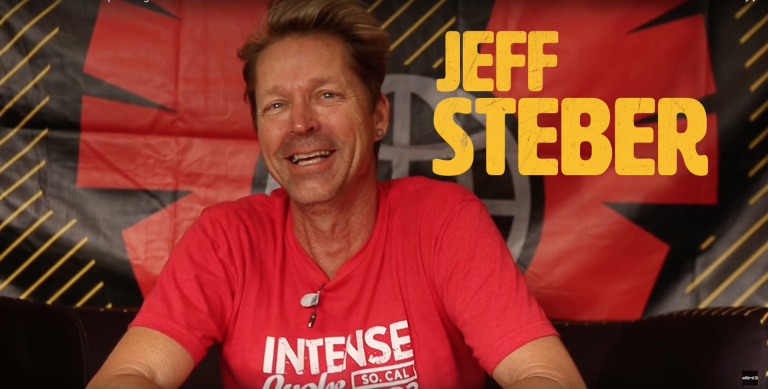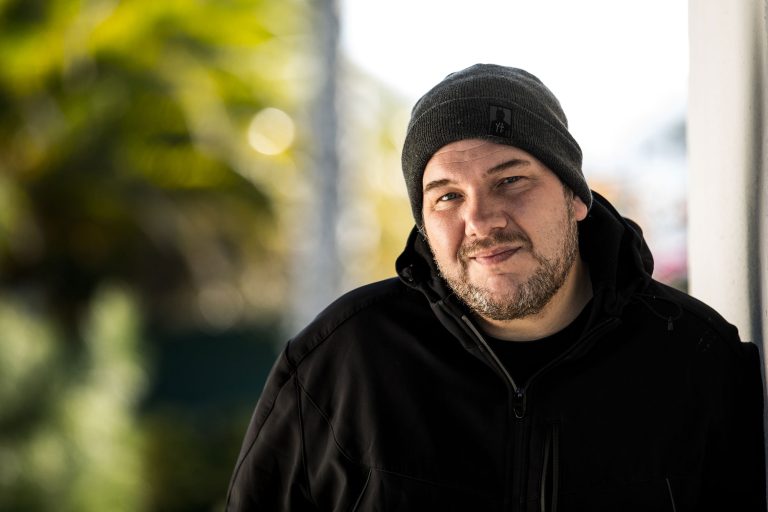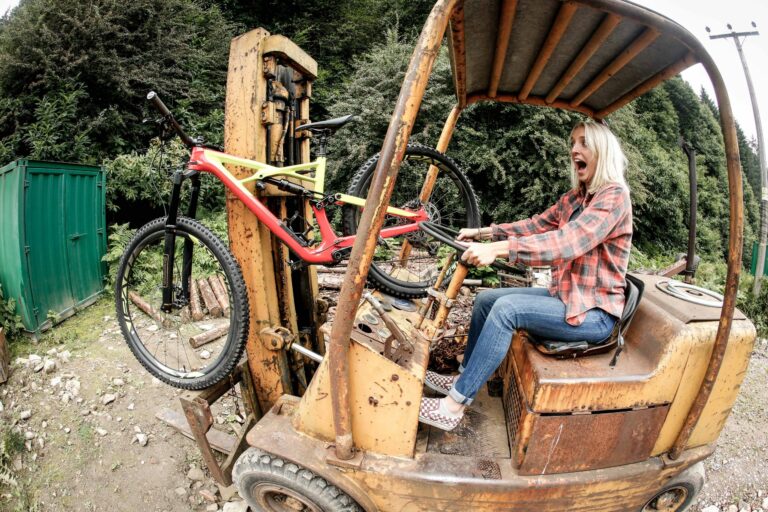Shaums March has been involved in mountain biking for quite a long time. Having made his mark on the DH race circuit, he turned his attention to freeride. These days he focusses on helping other people to ride better. We caught up with him at a distinctly damp Fort William…
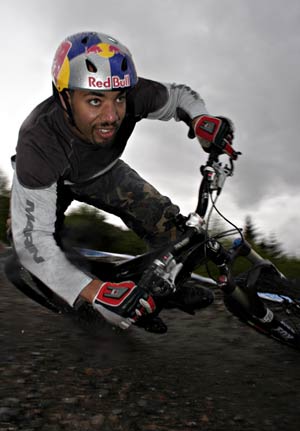 Your coaching company, Mad March Racing, is billed as “international” – how many countries have you worked in?
Your coaching company, Mad March Racing, is billed as “international” – how many countries have you worked in?
We’ve done Jamaica, Hawaii, US, Canada, and now the UK. We’d like to do some other countries so we’re still looking.
Do people come to you and say, “Hey, come to Jamaica” or wherever?
Yeah, pretty much. Right here with Marin it’s a great connection – we’ve got dealers and reps and it makes doing something like that real easy. We can travel around or we can bring people to Canada and they can do a tour and see more than just one mountain. I think we’re one of the only camp companies that focus on actually teaching rather than just “go ride with a pro”.
How easy is it to teach somebody to ride bikes better? It’s kind of a fledgling industry…
It is. I think I have a leg-up because my mother was a teacher and I went to college and became a teacher so I feel I can relate to different things, describe skills in different ways. That’s the hardest part – to say something and then be able to say it again in a different way, but meaning the same thing so people can understand it. If they don’t get it the first time, you gotta translate it a different way.
Do you find that when you start teaching someone something you start to understand it better yourself?
Yeah, you start breaking it down for people and it makes you realise what you really do. I think I started riding faster just by coaching. In 2003 I didn’t do a race all year, I went and did a little media tour along the US East Coast doing some photos and video. I just happened to be at the NORBA nationals so I decided to race. And I podiumed, I was 4th and I was like, “Hey, that was cool”. I hadn’t raced all year but I think because I was coaching so much it really made me feel what I needed to do to go fast.
There’s a bit of a thing in the UK at the moment about safety on trails, purpose-built stuff – the trails are getting harder, the bikes are getting more capable but people still just think, “It’s just riding a bike, I can do that…”
Yeah, the one thing we hear the most of that really scares us as coaches and riders, is when you go to a mountain and you can rent an FS bike and they say, “Just get the full suspension, you can go as fast as you want…” And it’s like, oh great, now you know they’re gonna get hurt. One thing we did with Whistler, when I helped them build their freeride park [the Boneyard], we decided on making test obstacles before you could get in to a hard course…
Qualifiers?
Yeah, qualifiers. So, you know, a gap that if you couldn’t do that you shouldn’t ride the rest of the course. If people are walking their bike on that section you know they shouldn’t be there.
So you have the hardest bit at the beginning?
Not even the hardest bit, but a technical bit that challenges their skill.
If you look at the kinds of sports that people lump in with mountain biking, like skiing, snowboarding, kitesurfing and all that stuff, none of them people would think of just doing – you wouldn’t just go and get the kit and then go kitesurfing…
…no, no, you’d want to take a lesson, sure.
Do you think that’s the way mountain biking is going?
It’s the way, yeah. Another way to think about that is that it’s the only sport that you just get on and you do it, riding trails. But if we were coaching for any other sport, you’d run drills. You don’t do that in mountain biking, they just say, get on your bike and go. So that’s one thing I’ve broken it down to, is to actually run drills. All my students that I’m coaching for racing, whenever we meet we have a half-hour of drills we run, just like you would in soccer. So that’s what we’ve brought it back to – you run drills and that helps your riding for the rest of the day. When people first come in and they see what we do, they’re usually a little stunned – “You’re going to make us do this for a half-hour?” And then once we’re done doing the drills, they realise, “This is what I needed.” And it’s good, because then they’ve got a list of stuff they can do at home and it’s very basic.
In terms of what you’d be teaching people, do you perceive any difference between downhill riding and cross-country riding or just riding for the hell of it?
I think the racing side of it is just a different aspect of coaching. You’re a little more aggressive, you worrying about the really minute movements and the preparation… It’s basically just making sure that everyone understands what they’re looking for. If they’re going to be a freerider, it’s not really about going fast, you want to make sure you know what gear you’re in so you don’t slip a gear when you’re going off a drop, things like that. A lot of the Xcers, don’t want to lower their seats to do the hard stuff, they want to run it higher. Those are the kinds of things that you’re getting into – you don’t want to set everybody’s bike up like a freeride bike, you gotta keep them with what they came in with and then you work around the skills. That may alter a little bit according to their bike, so they have a skill but then they have a little technique that’ll work for them and their bike.
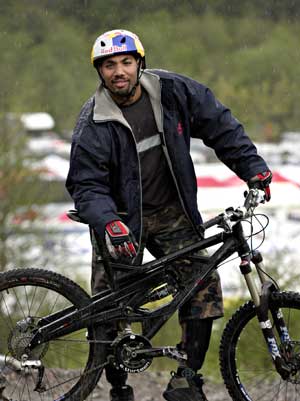 Are you mainly working with people who are wanting to race and get faster?
Are you mainly working with people who are wanting to race and get faster?
We have a mixed group, for sure. We usually get half-and-half. We get a lot of people that are just freeriders and people that are out of the office. Usually what we find is that they’ve gone to one or two other places to go do a camp and they’ve found out it’s just “ride with a pro” or going for a guided ride. But they’re actually looking to learn something so they can go out and be safe around their trails. The older guys definitely are looking to learn, the younger guys are really looking to go faster. And it’s cool because we can bring in the 40 and 50 year olds with the 15 year olds and they’re going to learn really quickly that their riding can get better really fast. They can be confident in what they’re doing within a half-hour, an hour, just with some basic things. And then we start breaking it down and getting a little more into it.
Did it take a while to get the momentum, getting people into the idea of coaching? There isn’t really a culture of it in mountain biking…
No, exactly, it’s: “I know how to ride my bike, I learned when I was five.” That’s what everybody says. And you just have to explain it to them. When you show them a couple of basic things they realise, “Oh, I guess I don’t really know”. And yeah, everyone knows how to drive but do you know how to race? A race car driver and a driver are different. I think once you explain it, show people a couple of basic things they really understand it.
You’re with Marin for bikes...
We just got on Marin this year, we’ve got a good three-year contract now. And that’s with the camps and everything, so it’s a new turn and a new twist. A lot of my sponsors have been saying they want someone to race and do freeride comps. And I just had a baby and, you know, I want to make a business out of this. I don’t just want to be a racer all my life, and there’s a lot of people out there that see that. So a lot of our sponsors stayed with us and a few of ’em said, we want a racer. And they can go find a racer.
And Marin is moving into a part of the market that it hasn’t really operated in before, with the Quake. Have you been involved in the development of that?
We came on board right when they had it, so now what we’re doing is we’re being able to tweak it. So the first year we’re going to ride it and the next year I think we’re going to have a lot of input on what comes out after it. I know they want to do a DH version, they want to do some more XC versions as well. So yeah, we’re going to get into helping them to tweak it so it comes out right.
You’re happy with the bike as it is, though?
Right now I’m really happy with it. It’s amazing, ‘cos I know I got on it and I rode it and it didn’t feel like their was anything out of the ordinary, it just felt really nice, it was comfortable and it rode fast, and it was compact. And then when I actually did measurements they didn’t look right, but when I rode it, if felt great. So I’m still in my head trying to figure out, how does the bike work so well when the measurements don’t tell me it should? But it works. And I think that that’s what a couple of other people have found when they’ve done testing on it, you know, it rides great but then they measure it and they go, ah, well, the measurements are wrong. But they’ve done the suspension geometry and got the angles set up where it seems to work great.
Have you met Jon Whyte?
I haven’t met him yet. I haven’t talked to him personally, I’ve been doing emails through Marin to him. I can’t wait to actually meet him. The Quake right now, as an all-mountain bike, he’s spot on with that bike. I really wouldn’t change much, the small size feels like maybe it could be a little lower on the standover height, but other than that, feels great. The spec’ on them feels great right now. And I’ve been beating on it for the last three, four months and I haven’t had any problems. I think I Loctited a couple of bolts and that was it. So I’m impressed that, with a first shot at it, he’s got it dialled right now.
Plans for the future?
A lot of plans, not all in mountain biking. Probably doing some of my own events, getting a team together and doing more coaching and camps. I’m doing a little bit of off-road racing in trucks and on motorbikes, and, you know, living with the family, new baby and all that.
You’ve got two camps coming up in the UK…
Yeah, we’ve got the two kids’ camps this weekend, so those’ll be really neat. I just saw the ad for it and it looked really cool and they said it had a great response, so I’m excited to see what the kids are like and what kind of riding we have here. I think that the word’s going to spread after these guys go through it and see how much they can learn in an afternoon – I think it’s going to be cool.


